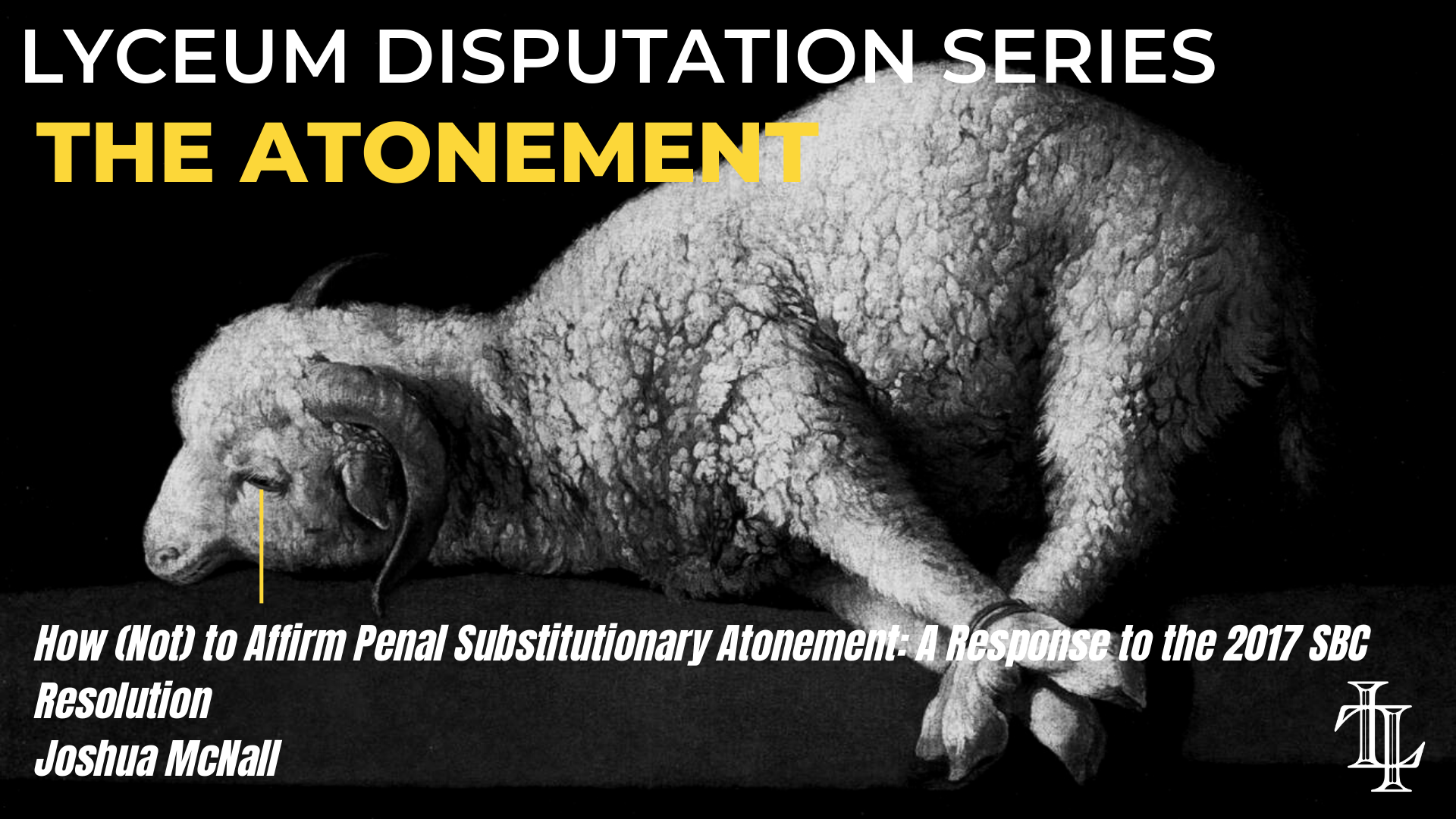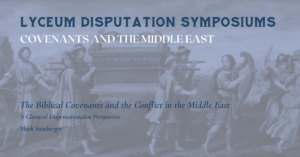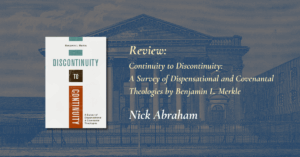Editor’s Note: This is part 1 in our Lyceum Disputation series considering the necessity of Penal Substitutionary Atonement as described in this 2017 SBC resolution. Stay tuned for further installments. As with all our work, the London Lyceum publishes a range of viewpoints to encourage thinking.
What is modern life if not an endless argument over acronyms? CRT, MAGA, BLM, LGBTQIA—and in some theological circles—PSA (penal substitutionary atonement). Since I am neither a Baptist nor the son of a Baptist, I was reticent when asked to respond to the 2017 SBC resolution “On the Necessity of Penal Substitutionary Atonement.”[i] If there’s one thing I assume the Southern Baptists don’t need, it is one more person on the internet with opinions on their yearly meetings. Nonetheless, I appreciate the invitation for at least two reasons: First, I have many wonderful friends within the SBC. And second, my academic research has focused, in recent years, on the doctrine of atonement. Amongst other things, I have argued extensively that Scripture and tradition provide solid grounds for supporting a nuanced version of PSA.[ii]
The question, however, is not just if one affirms PSA, but how one does so—because there are good and bad ways to do it. After reviewing the resolution, my conclusion is that, regrettably, the 2017 SBC document has some serious weaknesses. In a nutshell:
- It fails to define the position (PSA) it seeks to defend.
- It asserts conclusions without arguing for them.
- It introduces red herrings, like the supposed danger(!) of Christian pacifism.
- It oversimplifies the biblical evidence, especially on sacrifice.
- It misidentifies and conflates key passages (Lev 16 and Exod 12).
- It uncharitably claims that those with differing views are false teachers.
- And it leaves out voices from church tradition which could help its case.
As a result, the resolution falls short of the kind of careful, gracious, and theologically fluent work that could be provided by the many wise and gracious figures in the SBC. By pointing out these imperfections, my goal is not to throw stones at the SBC, but to highlight areas where those of us who affirm PSA can do better when articulating the doctrine for the good of the church.
SOME POSITIVES
To avoid the impression that my assessment is wholly negative, here are four positives from the 2017 resolution. First, I wholeheartedly agree that there is a biblical and historical basis for penal substitutionary atonement—at least when each of those words is rightly understood. Second, in harmony with the resolution, I likewise want to distance the biblical logic of PSA from the slur that it must necessarily present a “monstrous” and “abusive” view of God. Third, I agree with the resolution’s attempt to root atonement doctrine in God’s love, justice, and holiness. And finally, I applaud how the latter sections of the resolution assume a posture of worship rather than of turgid argument or polemic grandstanding. Indeed, the next to last “Whereas” says nothing of PSA and simply celebrates that history ends with people from every tribe, tongue, and nation crying “Worthy is the Lamb!” (Rev 5:12). Amen!
All these factors mean that the 2017 resolution is not entirely devoid of worthwhile elements. Nevertheless, the significant flaws in the document mean that even supporters of penal substitution should say—to misquote the Mandalorians of Star Wars fame—“This is not the way.”
WHICH PENAL SUBSTITUTION?
One of my frustrations in studying the ever-mounting literature on PSA has been that both the most vociferous defenders and detractors of the model often share a common weakness: Namely, they never bother to define it. In the absence of a minimal definition (what I have elsewhere called “mere penal substitution”), partisans of all varieties often arrive only to find the terminological house swept clean and left unoccupied. Into this vacancy rush a great variety of unstated assumptions, the debate gets muddled, and the final state of the doctrine is worse than the first (cf. Matt 12:44-45).
When it comes to PSA, it is not enough to “exorcise” false claims; one must also fill that space with a careful, positive definition. Indeed, this kind of minimal and nuanced definition is even more necessary in a time when extreme voices have sought to radicalize PSA to mean not only that Christ freely chose to bear the divinely sanctioned judgment for sin, but that the Father made the Son the object of his perfect hatred (the so-called Christus Odium view).[iii] Almost no one in history—from John’s Gospel, to John Calvin, to John Wesley, to John Stott—would affirm this Trinity-imperiling perspective. But it is a view that has gained traction with some outspoken evangelicals in recent years, including one of the co-drafters of the 2017 SBC resolution.[iv] Thus, we are left with serious questions over which version of PSA is being endorsed as a supposed “Necessity.”
“WHEREAS” IN PLACE OF EVIDENCE
Another troubling aspect of the resolution rests in the way the word “WHEREAS” is used repeatedly in place of any evidence or argumentation. In this fashion, the word becomes a cipher by which to smuggle in assertions that—while serious if taken to be true—have not been stated or even argued for. We are told that a denial of PSA is “in effect the denial of the perfect character of God” (sect. 7) which constitutes “false teaching that leads the flock astray” because it “leaves the world without a message of a sin-cleansing Savior” (sect. 8).
These are bold claims. But while they may be effective in rallying a convention crowd—like a politician offering “red meat” at a political gathering—when one goes searching for the basis for the damning accusations one often finds only a single bureaucratic placeholder (“WHEREAS”)—as if contextualized biblical reasoning could be excised in favor of parenthetical prooftexts and a nod to Robert’s Rules of Order. Once again, though I have been as public as anyone in my defense of PSA, I must say: This is NOT the way.
EQUATING PSA WITH A POSITIVE VIEW OF VIOLENCE: A RED HERRING
Probably the strangest section in the resolution involves a critique of so-called “anti-violence” models of the cross (sect. 3). To be clear, I too have been critical of certain so-called non-violent models of atonement—at least as explicated by theologians like J. Denny Weaver or René Girard.[v] The reason for disagreeing with such theologies, however, need not involve a disdain for Christian nonviolence. Once again, the problem comes in the way the 2017 resolution frames its case.
In the SBC document, the fear appears to be (and I wish I were making this up…) that people might wrongly look at Jesus and find grounds for pacifism if it were not for PSA swooping in to justify our violence. To swat down that result, we find another parenthetical prooftext (Rom 13:4) and another naked assertion: that pacifist applications of Christ’s work supposedly “weaken” biblical teaching on the need for force in some circumstances.
This is a very odd defense of PSA—and I say that as one who agrees(!) that certain earthly authorities have a God-given duty to use measured force to protect the vulnerable and bring justice. By the resolution’s logic, one might just as easily condemn PSA for encouraging nonviolence in the face of aggression. After all, that is precisely the worry of some feminist and Liberationist theologians. They allege that vulnerable people continue to acquiesce in the face of violence because they have been taught a mangled version of PSA. So which is it? Is PSA bad because it encourages non-violence? Or is it good because it reveals the need for human violence? In fact, the doctrine need not be read in either way.
This section (sect. 3) is an exercise in changing the subject and enlisting a feared boogeyman (“pacifism”) as if it were evidence. To employ this red herring reminds me of the old joke about my own theological tradition: Namely, that we reject premarital sex out of a serious concern that it might lead to dancing. When it comes to theological argument, this is not the way.
OVERSIMPLIFYING SACRIFICE
The 2017 resolution also oversimplifies and misstates the biblical evidence regarding sacrifice. PSA is thus seen to be correct because “the sacrificial system of the Old Testament culminated in the blood sacrifice of a spotless lamb [sic] on the Day of Atonement” (sect. 11). This is an odd claim since the Day of Atonement did not involve a spotless “lamb” (that would be Passover),[vi] and the fact that no one noticed such an error raises questions about how much care, or how much scholarly collaboration, went into the resolution.
At the risk of beating a dead, exiled, or misidentified goat, I have argued in print that there is a penal substitutionary component in the rituals of Yom Kippur. So I have no problem with arriving at that verdict. But it matters how one gets there. My own conclusion is as follows:
In the Day of Atonement, as with Calvary, the language of “in our place, instead of us,” still seems best when speaking of the elements of (1) sensory experience [i.e., what Jesus experienced on the cross] and (2) active agency [i.e., what Jesus willingly undertook to atone for us]. Beyond this, … a strong case can be made that the banishment and presumed death of the sin-bearer has the penal connotations that exile has elsewhere within the Torah. For these reasons, Yom Kippur appears to present us with an image of penal substitution joined with vicarious judgment. One need not accept a false choice between these two options.[vii]
Aside from the conflation of Passover and Yom Kippur, a deeper problem emerges in the way blood sacrifice is simply assumed to mean PSA without the aid of any argument or evidence. The biblical material deserves more care than that. There are a number of fine scholars who read blood sacrifice as often involving a kind of inclusive place-taking that is not synonymous with penal substitution. The careful work of these individuals should not be smeared as that of “false teaching” bent on leading the flock astray.[viii] This sort of denunciation may boost one’s Twitter following, but it is beneath the dignity of careful scholars and charitable Christians. In sum, one should not simply cite (or mis-cite) an example of blood sacrifice as if a parenthetical Bible verse ends the discussion over PSA within the canon.
A POTENTIAL OBJECTION
At this point some readers may rightfully raise the following objection to my criticisms: Yes, yes, we should acknowledge that the biblical material on atonement deserves a lengthier treatment; but doesn’t the nature of a conference resolution prohibit that kind of careful analysis? After all, the SBC’s 2017 statement is not a book, an academic journal article, or even a lengthy scholarly blog post. Thus, to criticize its lack of evidence or detailed argument might be a category mistake. Could not one also make the same charges against other venerable statements of Christian doctrine: say, the Nicene or Apostles’ Creeds? After all, these statements are also necessarily brief, and the early creeds were often forged in the fires of polemic disagreement—even if it happened long before the age of Twitter.
Fair enough. We should be clear about the limits of a resolution. But those limitations do not mean that scholars and church leaders are left with only two options: (1) say nothing on atonement doctrine, or (2) knowingly oversimplify the argument and mischaracterize opponents. A much better approach would be to follow the lead of the church universal in setting forth a variety of biblical images and models of atonement—including a nuanced rendering of PSA—without feeling the need to anathematize others as “false teaching” (sect. 8), or single out one model as most important. This latter tendency is a uniquely modern error,[ix] and it is high time that both the most impassioned detractors and defenders of penal substitution move beyond it.
BEYOND BIBLICISM: HOW TRADITION CAN HELP
One way to achieve this more harmonious and historically rooted approach to atonement doctrine is to do something that the 2017 resolution fails to do entirely—namely, to reference church tradition as yet another reason to support a nuanced version of penal substitution. The closest the resolution comes to this move is the claim that “Baptist pastor-theologians and scholars with differing soteriological convictions” have long made PSA “the foundation of their ministry” (sect. 16). That last claim should raise serious questions since it is not a lone model of atonement but the gospel itself (or simply, Jesus the Messiah!) that should serve as our ministry foundation. Nonetheless, there is a passing reference here to Baptist tradition.
Despite the importance of that heritage, church tradition runs much deeper—as does the church’s affirmation of a nuanced form of penal substitution. Thankfully, there is a laudable movement within Baptist circles to acknowledge that reality. Networks like the Center for Baptist Renewal are seeking to retrieve the beliefs and practices of the global church across the centuries, especially as this pertains to the patristic inheritance.[x] This appeal need not mean a rejection of Protestant distinctives like sola Scriptura, but it does mean moving beyond a biblicism which seeks to buttress unargued claims by simply sprinkling in some parenthetical Bible verses and then implying that everyone who disagrees is false teacher who “leads the flock astray” (sect. 8).
Earlier church tradition never took this sectarian line on atonement doctrine. Still, there were notable figures—like Eusebius of Caesarea, Athanasius, John Chrysostom, Augustine of Hippo, and Gregory the Great—who affirmed the core components of what I have elsewhere dubbed “mere penal substitution.”[xi] These early figures also avoided the crass modern caricatures that would equate PSA with divine child abuse or with the broken Trinity that invariably results from an affirmation that the Father ever “hates” the Son upon the cross or utterly forsakes him.[xii] I have no space here to rehearse the full historical case for PSA within the patristic era,[xiii] nor is every attempt to locate the doctrine in the Fathers sufficiently careful.[xiv] Key differences exist between patristic and modern emphases within the doctrine.[xv] But suffice it to say that the old smear that PSA is not even as old as the pews in some historic churches has now been widely rejected.
How might the 2017 resolution have acknowledged this reality in a way that kept its case from resting almost exclusively on a biblicist foundation? Perhaps a further section could have read as follows:
WHEREAS, different forms of PSA have been affirmed throughout church history, not only since the Reformation but also in the patristic era, we take confidence in adding our “Amen!” to that great cloud of witnesses.
That sentiment should be fully acceptable within the context of the SBC, and it would go a long way toward dispelling the “Just me and my English-language Bible” caricature that haunts both evangelical and fundamentalist congregations within America.
CONCLUSION
To avoid ending on a curmudgeonly note, here is one more positive for which we can all rejoice. The sufficiency of Jesus’ saving work does not depend upon our faulty attempts to defend it. The Messiah saves not only from willful sins, but from ignorance. And that reality is especially good news for pastors and theologians like myself, since we cannot help but fall short in our articulations of atonement. Jesus is not only our penal substitute but the true Adam, the true Israel, our moral example, our teacher, our representative, our vicarious judgement-bearer, our healer, our devil-destroyer, and our victorious and coming King.
The way forward in atonement doctrine involves reclaiming all these themes and more—not as a kaleidoscope of disconnected images, nor as a defensive struggle for the dominance of one model, but as an integrated whole that testifies (albeit imperfectly) to God’s saving work in Christ. In this interwoven tapestry of salvation, the crimson strand of penal substitution finds its place, not as a combatant in an endless culture war where ambiguous acronyms clash by night, but as an important thread that binds together aspects of atonement.
[i] https://www.sbc.net/resource-library/resolutions/on-the-necessity-of-penal-substitutionary-atonement/
[ii] Joshua M. McNall, The Mosaic of Atonement: An Integrated Approach to Christ’s Work (Grand Rapids: Zondervan Academic, 2019).
[iii] For a critique of this extreme and novel form of PSA, see Joshua R. Farris and S. Mark Hamilton, “This is my Beloved Son, Whom I Hate? A Critique of the Christus Odium Variant of Penal Substitution,” in Journal of Baptist Theological Studies, 3.2 (2018), 271–86.
[iv] See Owen Strachan’s presentation on the Christus Odium debate during the 2019 meeting of the Evangelical Theological Society. https://www.wordmp3.com/details.aspx?id=35367.
[v] See J. Denny Weaver, The Nonviolent Atonement (Grand Rapids: Eerdmans, 2001). Rene Girard, I See Satan Fall Like Lightening, trans. James G. Williams (Maryknoll, NY: Orbis, 2001).
[vi] Leviticus 16:5 references a śāʿir (male goat) while Exodus 12:5 refers to a lamb (śeh) without spot or blemish.
[vii] McNall, Mosaic of Atonement, 134.
[viii] See, for instance, John Goldingay, “Old Testament Sacrifice and the Death of Christ,” in Atonement Today, ed. John Goldingay (London: SPCK, 1995) 3–20. See also the so-called Tübingen perspective on Hebrew sacrifice.
[ix] Talk of “theories” or “models” of atonement is mostly limited to the past two hundred years. See Adam J. Johnson, “Atonement: The Shape and State of the Doctrine,” in T&T Clark Companion to Atonement, ed. Adam J. Johnson (London: T&T Clark, 2017), 9.
[x] http://www.centerforbaptistrenewal.com
[xi] McNall, Mosaic of Atonement, 101.
[xii] See again the Christus Odium discussion above. For a helpful treatment of the Cry of Dereliction, and one that avoids a broken Trinity while still taking Scripture at face value, see Thomas H. McCall, Forsaken: The Trinity and the Cross, and Why it Matters (Downers Grove, IL: IVP Academic, 2012).
[xiii] For that argument, see McNall, Mosaic of Atonement, 107–26.
[xiv] See Steve Jeffery, Michael Ovey, and Andrew Sach, Pierced for Our Transgressions: Rediscovering the Glory of Penal Substitution (Wheaton, IL: Crossway, 2007).
[xv] See Benjamin Myers, “The Patristic Atonement Model,” in Locating Atonement: Explorations in Constructive Dogmatics, eds. Oliver D. Crisp and Fred Sanders (Grand Rapids: Zondervan Academic, 2015), ch. 3. While Myers’ work is fantastic, my own argument is that the core components of “mere PSA” can coexist with the unique patristic emphases he outlines in the chapter. See again McNall, Mosaic of Atonement, 117–18.
Author
-

Joshua McNall (PhD, Manchester) is Associate Professor of Pastoral Theology and Ambassador of Church Relations at Oklahoma Wesleyan University. He is the author of several books, including, Perhaps: Reclaiming the Space Between Doubt and Dogmatism (IVP Academic, 2021), and The Mosaic of Atonement: An Integrated Approach to Christ’s Work (Zondervan Academic, 2019). He blogs at www.joshuamcnall.com and hosts the Outpost Theology podcast. Josh and his wife Brianna have four children: Lucy, Penelope, Ewan, and Teddy.
View all posts




